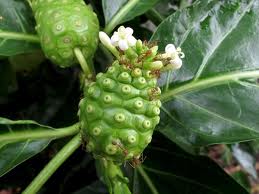| PlantID | 0090 |
| Botanical Name | Morinda tomentosa |
| Common Name | Maddimara |
| Classification | | Kingdom: | Plantae | | Subkingdom: | Tracheobionta | | Division: | Magnoliophyta | | Class: | Magnoliopsida | | Subclass: | Asterids | | Order: | Gentianales | | Family: | Rubiaceae | | Genus: | Morinda | | Species: | tomentosa |
|
| Part used | Root, Leaves, Fruits |
| Medicinal Properties | Leaves: tonic and febrifuge. Roots: styptic, astringent, cathartic and alexiteric. Fruits: tonic. Fruits(riped): mild, laxative.
|
| Medicinal Use | Leaves & fruits: useful in fever. Roots: used for bowels (dries boils), infusion as a bath. This plant also useful in diarrhea, wounds and ulcers, spongy gums. |
| Chemistry | Heartwood: morindone, damnacanthal and nordamnacanthal (1,3-dihydroxy-2-formylanthraquinone), anthraquinone easter-tinctomorone. Root-bark: morindone diglucoside (Morindonin), 6-primeveroside of morindone. Stem-bark: alizarin-1-methyl eather, rubiadin and mannitol. Leaves: ursolic acid. Oil: fatty acids, campesterol, stigmasterol and bita-sitosterol. |
| Cultivation | NA |
| Regional Habitat | Frequently founds in forests on Aravalli hill ranges. Distribution: Kota and jhalawar districts.
|
| Description | Trees, 5-8 m tall. Young branches 4-angled tomentose. Leaves: stipules acute or often bifid, lobes acute; lamina attenuate at the base, elliptic/elliptic-oblong or lanceolate, thinly coriaceous, surfaces tomentose, veins conspicuous, lateral-veins 4-6 pairs, apex acute or acuminate, margins entire. Flowers: 5-merous, sweet-scented; calyx tube cohering, limb short, truncate, sometimes with 1-2 foliaceous lobes; corolla white, tube hairy outside, lobes oblong, obtuse or sub-acute; anthers included. Fruits: 0.2 cm across, irregularly globose or ellipsoid, fleshy syncarpium. Flowers appears during August-September and fruits appears during October-December.
|
| Image |  |


